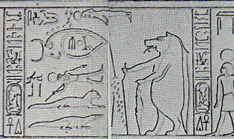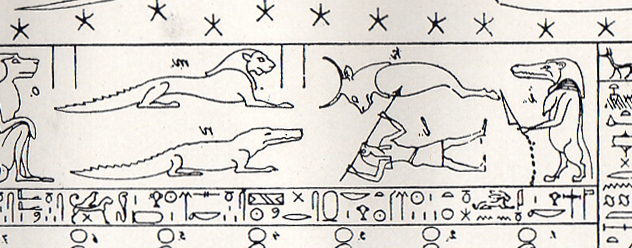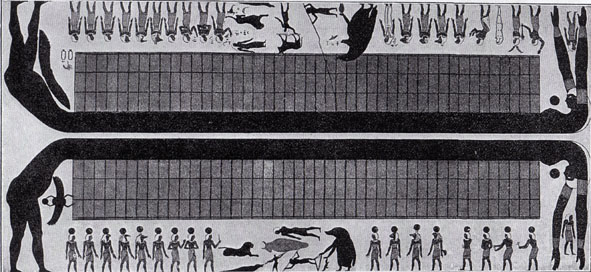![]()
![]()
Andrew Collins answers further queries from Robert Bauval on the role of the falcon-headed deity dwn-'nwy in ancient Egyptian astronomy
Still holding his own, Andrew Collins
answers further queries from Robert Bauval, co-author of THE ORION
MYSTERY, on whether or not the falcon-headed deity dwn-'nwy is Cygnus,
following a new posting on the Graham Hancock message board (GHMB).
A Response
to Robert Bauval from Andrew Collins, dated 10.04.07.
On 08 April 2007 Robert Bauval wrote on the GHMB:
> Hi Andy,
>
> I really have to keep telling you that your confidence that
> Dwn-nwy is Cygnus is very much ill-founded. Graham Chase is
> absolutely correct in pointing this out to you, as I have also
> done on several occasions as well.
AC: I fully understand your views, Robert, but don't agree with them.
> I have clearly demonstrated to you on this GHMB using
> straightforward logic that the figure of Dwn-nwy on the Senmut
> ceiling (or indeed on any other of the Ramesside, Seti I or the
> Ptolemaic astronomical drawings) cannot possibly be Cygnus. The
> position of Cygnus in the sky and the position of Dwn-nwy on
> these drawings simply do not tie up, not by a long shot.
AC: I have clearly shown in my article
http://www.andrewcollins.com/page/articles/dwn_nwy.htm
that dwn-nwy can be Cygnus, and
that there is every reason to consider this as possible.
> Graham Chase and myself are not the first to have demonstrated
> this blatant incompatability.
AC: Yes, as I pointed out, I am aware of the current trend among archaeoastronomers
away from this conclusion. However, these conclusions are based on
the misconception that the astronomical ceilings are meant to be read
as accurate sky maps, when they are merely compacted views, albeit
approximately placed, of circumpolar and near circumpolar asterisms.
You cannot make an acetate of the sky figures and overlay them on the constellations of the northern sky and get an accurate match. They were symbolic approximations only, meant only to inform the soul on its path into the afterlife.
>It has long ago been pointed out
> by Neugebauer and Parker (1964-9), and more recently by Donald
> Etz (1997) by Maravellia (2003) who used the very same logical
> as Graham Chase has outlined.
AC: I have outlined why I believe these individuals are wrong in my
earlier response to your many postings on the subject. This is found
at
http://www.andrewcollins.com/page/articles/Bauval_Cygnus_Orion_Giza_020407.htm
I will not repeat them here, only to say that I have more confidence in the work of the visionary founders of archaeoastronomy than I do these modern interpreters.
>The same, too, by Locher (1985)
> and Belmonte (2003) who have placed Dwn-nwy in completely
> opposite positions than Cygnus using the same logic.
AC: Ditto my last statement.
>
> I have read you article on Dwn-nwy and I find that you argument
> is devoid of such astronomical logic, and whatever astronomical
> logic you apply is erroneous.
AC: You are welcome to your opinion.
>Your keep evoking Wainwright,
> Zaba, Lauer and Stecchini, while rejecting the conclusions of
> the 'modern archaeastronomers'.
AC: You keep invoking Locher, Maravellia, Belmonte, etc.
You yourself have questioned the reasoning of Maraveillia regarding her proposal that the mis alignment of the Great Pyramid being caused by geological shifts.
>This is a fatal mistake that
> you are doing. Those 'modern archaeoastronomers', as you call
> them, have presented arguments based on proper observational
> astronomy and common sense logic.
AC: Again, these are merely opinions, which you have chosen to accept. This does not make them correct.
>
> Also you seem to also be placing much faith on Zaba's
> conclusion that the 'spear' or 'rod' held by Dwn-nwy represents
> the meridian.
AC: I actually came to this conclusion separately to Zaba, but then
found that he had said the same.
>In all the AE drawings (except one, Ramses VI)
> the spear/rod cannot be the meridian, since it is clearly held
> by Dwn-nwy at an [i]angle[/i] to the meridian.
AC: This connection in artistic form is not meant to be astronomically precise, only symbolically important.
We have also the Mooring Post to deal with, which probably is based on the pre-pyramid age role of Alpha Draconis as the pole star, swinging the bull/ox thigh around the celestial pole. All this shows that by the New Kingdom period the whole concept of what the meridian once represented was being lost.
By the time we come to astronomical ceilings in the Late Dynastic and Ptolemaic period, much confusion will have set in.
>This is very
> evident on the Senmut celing, where the meridian is clearly the
> long pole joining the bull's thigh and the ground and not
> Dwn-nwy's spear/rod (even Lauer acknowledged this fact in his
> review of Zaba's work).
AC: Okay, I pre-empted what you were about to say here. As explained, the Mooring Post is the celestial pole. Yes, this could be seen as the meridian, but so was the cord between dwn-nwy and the ox thigh/bull. They were two forms of essentially the same thing, although featured for different purposes - one to show the north-south meridian and the other to express the nature of the northern celestial pole.
> [img]http://www.andrewcollins.com/pics/senmut-ceiling.jpg[/img]
>
> The exception i.e. Ramses IV, shows the 'rod' (or 'rope'?) held
> by Dwn-nwy at the right place to be perhaps the meridian; but
> then even if that was the case, the position of Dwn-nwy is
> completely wrong to be Cygnus.
AC: Yes, dwn-nwy with the ox thigh floats around in relationship with the hippo, but always the falcon man is beneath the ox thigh and the hippo (Draco) is on the right, unless the whole thing is mirrored, which I disagree with you is not the original form of the sky-group.
Indeed, in some of the late ceilings the northern sky group appears twice, one with the hippo on the right and the other with the hippo on the left.
>I have noted that you have
> (correctly) pointed out that the northern constellations on the
> AE drawings are sometimes reversed, such that the hippo (Draco)
> is sometimes on the left and other times on the right of the
> bull's thigh (big Dipper);
AC: Again, pre-empting what you about to say. So, yes.
>I have also noted how you tried to
> show that the arrangement of the Seti I northern figures, with
> the hippo on the right of the Thigh, shows that Dwn-nwy falls
> where Cygnus is in the sky map. Here's your sky map:
>
> [img]http://www.andrewcollins.com/pics/skymap_cropped.jpg[/img]
AC: Correct.
> First of all your sky map is set for the present day,
AC: I did the whole thing very quickly, but the relationship of the
sky figures doesn't change whether it is 2600 BC or AD 2007 (other
than through proper motion, which is not worth considering here).
So my argument is the same. The relationship between dwn-nwy, the
ox thigh and the hippo match the arrangement of, respectively, Cygnus,
the main seven stars of Ursa Major and much of Draco, including the
head.
>as can be
> seen by the position of the star Polaris at the north celestial
> pole. Your sky map, therefore, need to be precessed to c. 1300
> BC and viewed from the latitude of Luxor in order to conform
> with the Seti I drawing.
AC: No, the arrangement of sky figures will never change.
>At that epoch Cygnus would have been
> more than 30 degrees [i]below[/i] the horizon, and thus
> obviously not visible; where as in the Seti I drawing Dwn-nwy
> is shown well above the horizon.
AC: It doesn't matter whether Cygnus dipped down below the horizon
or not, the arrangement of the three key constellations would not
have changed, and they would have been seen revolving around the sky
during much of the year. The AEs would have created the sky group
relationship not through one momentary glimpse of the stars, but from
continuing watching over a very long time.
>It is inconceivable that the
> ancient Egyptian astronomers would draw a sky image with such
a
> gross error, even if we allow them a wide level of artistic
> license as you suggest.
AC: No error as I said.
> Here's the correctly precessed
and positioned sky map for 1300
> BC Luxor:
>
> [img][img]http://www.robertbauval.co.uk/images2/Seti1c.bmp[/img]
AC: You cannot say that the northern sky group was conceived based
on one night alone in 1300 BC.
> Finally, your argument that
'Mace Man' on the round zodiac of
> Dendera represent Dwn-nwy is totally unconvincing.
AC: Again, your are welcome to your opinion in this respect.
>No
> Egyptologist or astronomer can agree with you on this.
AC: Certainly not when they are unable to see dwn-nwy as Cygnus. However, the position of mace man is clearly that of Cygnus as shown in 'The Cygnus Mystery' and in the above cited article by myself. Astrophysicist and arachaeoastronomer Eric Aubourg who has made a detailed study of the Dendera round zodiac in the Louvre agrees that mace man is Cygnus. I don't see any great controversy in this connection.
Thus if we go across to the rectangular zodiac and see that mace man here is replaced by dwn-nwy then surely this is evidence that the place occupied by both mace man and dwn-nwy corresponds with Cygnus. Again, I don't see what this should be controversial.
>At any
> rate, I have clearly demonstrate to you that 'Mace Man' on the
> round zodiac does not share the same position at Dwn-nwy on the
> rectangular zodiac.
AC: Both are between Sagittarius and Capricorn.
>Furthermore for the Dwn-nwy figure and/or
> the 'Mace Man' on the rectangular zodiac to be Cygnus as you
> claim, borth figures (or at least one of the figures) would
> have to be near or on the 'vulva' of the sky goddess, since you
> have sided with Ron Wells on this issue.
AC: The concept of Cygnus being the vulva of the sky-goddes Nut as proposed by Dr Ronald Wells relates more generally to Nut's role as the swallower and mother of the sun-god, not to the astronomical ceilings showing the northern sky group. Nut appears separately on such ceilings.
The connection between her and mace man is the cosmic goose, gengen-wer, the avatar of Geb (and also Amun and Atum), which almost certainly derives from a different cult centre to star lore seeing the falcon-headed god as Cygnus. Mace man is almost certainly a form of Geb. That he stands on the goose seems to bear this out.
As you well know, different cult centres would have held differing views on the interpretation of asterisms, in the same way, for instance, that Native American tribes hold similar differing views on the identity of constellations.
Yet in ancient Egypt, such differing views will eventually have been adopted into amalgamated views of the cosmos, causing totally conflicting views, and even duplications on very late sky maps, such the Dendera zodiacs.
This is why Cygnus is shown as mace man in one version of the zodiac and a falcon-headed god in another.
>But both the figures
> are near the head of the sky goddess, thus completely in the
> oposite place where you claim they should be. Your whole
> argument simply does not hold.
AC: As I have attempted to explain, by the time we get to the Ptolemaic period much of the ancient knowledge of star lore was being lost or confused causing duplications and reversals of figures. I don't see this as a problem to any theory.
>> Frankly I can understand why it is very important for you
that
> Dwn-nwy is to be correlated to Cygnus, and thus why you have
> placed so much faith in Wainwright et al. But simple
> astronomical facts and common sense logic tells us that this
> cannot be so.
AC: I accept what you say, but equally see why it would be important
for you to disprove that dwn-nwy is Cygnus.
I shall continue to refine my own findings, as I know you will yours,
Best,
Andrew Collins
In support of dwn-'nwy being Cygnus in ancient Egyptian astronomy, I show three further examples of the three major sky figures in relationship to each other:

The zodiac in the Ramesseum, c.
1200 BC, showing the bull as a floating torso, dwn'nwy as a horizontal
falcon-headed man with spear and the hippo on the right-hand side.
These three conform to the approximate positions in the night sky
of the key stars of Ursa Major, Cygnus and Draco.

Here are the same
three figures, this time from a zodiac of 800 BC reproduced by Brugsh
in his 'Recueil'. Since the figures can be shown either way around,
i.e. original and mirrored, I have mirrored this image so that the
hippo-croc hybrid is on the right hand-side. This clearly shows the
relationship between the three sky figures as Cygnus, Ursa Major and
Draco.

Astronomical drawings
from Biban el-Muluk (18th dynasty), taken from 'Description de l'Egypte.
Here we see the process of mirroring the sky group in one ceiling.
Above, the hippo is on the left-hand side and in the lower register
he is on the right. Although Robert Bauval believes it is the mirrored
form that was the original prototype for the northern sky group, I
argue it is the original form (as per Senmut's tomb) with the hippo
on the right.
TO RETURN TO MAIN PAGE CLICK HERE

To order signed copies of THE CYGNUS MYSTERY, click here now.
![]()
![]()